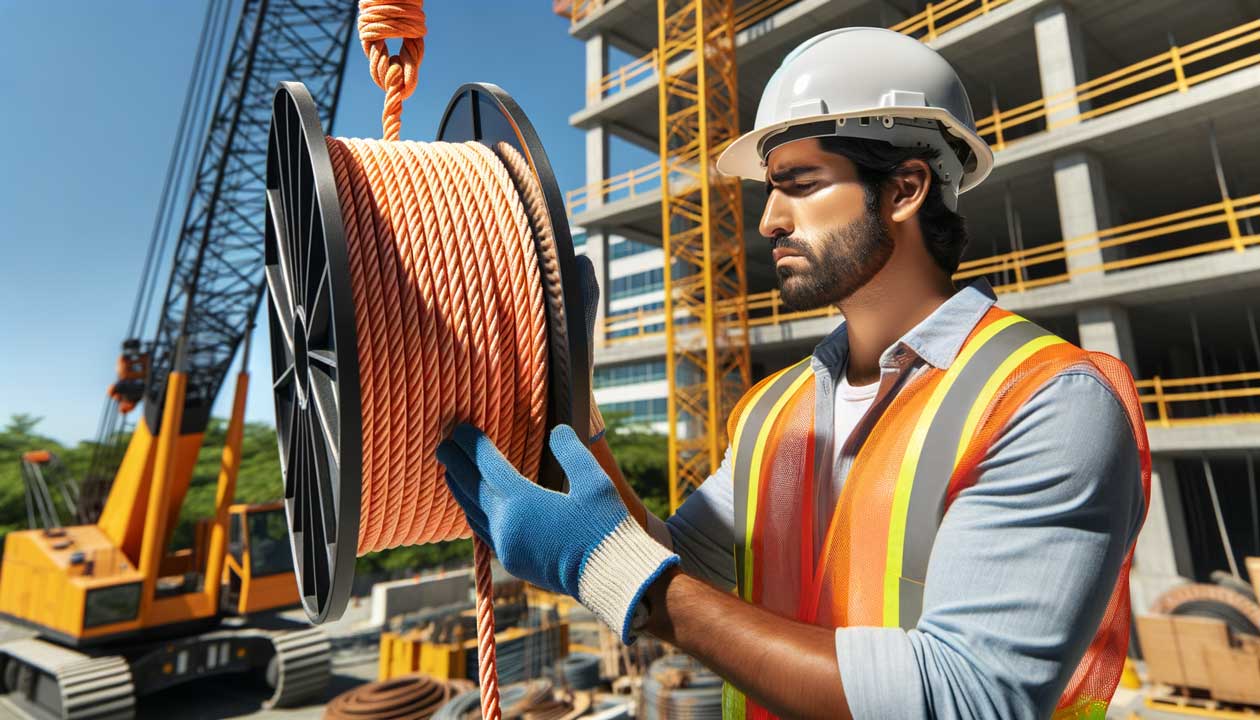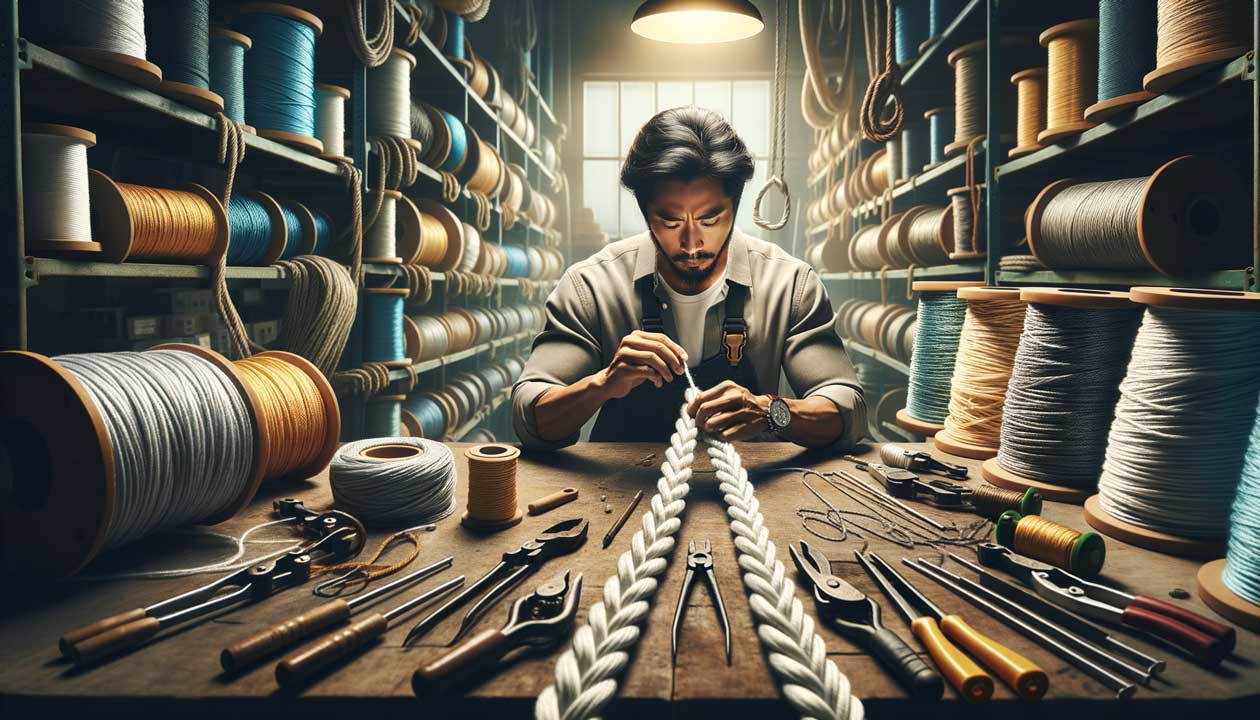In the world of ropes and cables, strength and durability are paramount. From towering skyscrapers to deep sea exploration, the right choice of rope can make all the difference. Two contenders stand out in this arena: UHMWPE (Ultra-High Molecular Weight Polyethylene) ropes and traditional wire ropes. While both boast impressive strength, their unique characteristics cater to different applications and environments.
UHMWPE ropes have taken the industry by storm, offering a groundbreaking combination of lightweight design and exceptional strength-to-weight ratio. Imagine a rope that feels as light as a feather yet possesses the power to lift heavy machinery with ease. This revolutionary material is redefining what's possible in industries ranging from marine to industrial and even recreational.
On the other hand, wire ropes have been the tried-and-true workhorses for decades, renowned for their exceptional strength and resilience in harsh conditions. From construction sites to offshore oil rigs, these rugged cables have proven their mettle time and again, tackling the toughest challenges with unwavering durability.
As experts in the field of high-performance ropes, we've witnessed first-hand the unique advantages and considerations of both UHMWPE and wire ropes. In this comprehensive guide, we'll dive deep into the key differences between these two powerhouses, exploring their strengths, limitations, and ideal applications. Whether you're a marine professional, an industrial operator, or an outdoor enthusiast, this insight will empower you to make informed decisions and choose the perfect rope for your specific needs.
What are UHMWPE Ropes and Their Unique Properties?
Have you ever wondered what makes some ropes stand out from the rest? Let me introduce you to a true game-changer in the world of ropes: UHMWPE (Ultra-High Molecular Weight Polyethylene) ropes. These high-performance ropes have taken various industries by storm, thanks to their exceptional properties that set them apart from traditional ropes and even strong wire ropes.
UHMWPE ropes are crafted from a special type of polyethylene that boasts incredibly long molecular chains. This unique composition gives them unparalleled strength and durability, making them suitable for a wide range of demanding applications, from maritime and industrial use to recreational activities.
What makes UHMWPE ropes truly shine is their remarkable strength-to-weight ratio. Imagine a rope that can handle heavy loads and withstand extreme conditions while being lightweight and easy to handle. That's precisely what UHMWPE ropes offer, outperforming both traditional ropes and wire ropes in this aspect.
Exceptional Strength and Lightweight
UHMWPE ropes are a marvel of modern engineering. They are an astonishing 7-9 times stronger than steel by weight, which means they can handle the same loads as steel wire ropes while being significantly lighter. This high tensile strength allows UHMWPE ropes to tackle heavy-duty tasks with ease, whether it's lifting massive loads or withstanding extreme tension.

Superior Durability and Abrasion Resistance
In addition to their incredible strength, UHMWPE ropes also boast superior durability and abrasion resistance. These ropes are designed to withstand the toughest conditions, from harsh marine environments to abrasive industrial applications. Their resistance to chemicals, UV light, and abrasion makes them ideal for use in situations where traditional ropes would quickly deteriorate.
Another notable characteristic of UHMWPE ropes is their low elongation properties. Similar to wire ropes, UHMWPE ropes exhibit minimal stretch under load, providing excellent control and predictability in critical applications. This low elongation ensures that the ropes maintain their strength and integrity even under intense strain.
So, where can you find UHMWPE ropes in action? These versatile ropes excel in a wide range of industries and applications, such as:
- Marine and offshore: Mooring lines, tow lines, and deep-sea lifting
- Industrial: Crane lifting, mining, and oil and gas operations
- Recreational: Rock climbing, sailing, and off-road vehicle recovery
Whether you're a maritime professional, an industrial operator, or an outdoor enthusiast, UHMWPE ropes offer unmatched performance and reliability in the most demanding situations.
Exploring the Strength and Durability of Strong Wire Rope
Now that we've explored the impressive characteristics of UHMWPE ropes, let's take a closer look at another heavy-duty contender in the world of high-performance ropes: strong wire ropes. These tried-and-true workhorses have been relied upon for decades in industries that demand exceptional strength, durability, and low maintenance.
Wire ropes are engineered to tackle the toughest challenges, from lifting massive loads in construction and mining to withstanding the harsh conditions of offshore oil rigs. But what is it about their construction and materials that make them so incredibly strong and long-lasting? Let's dive in and find out!
The Construction and Materials of Strong Wire Rope
At the heart of a strong wire rope's impressive performance lies its intricate construction. Wire ropes are typically made up of multiple strands of steel wires, carefully twisted or braided together to form a cohesive, load-bearing structure. The number of strands, the diameter of the individual wires, and the overall rope design all play crucial roles in determining the rope's strength and durability.
One of the most significant factors influencing wire rope strength is the material used in its construction. High-carbon steel is a popular choice for its excellent tensile strength and resistance to wear and tear. However, for applications that demand superior corrosion resistance, such as marine environments or chemical processing plants, stainless steel wire ropes are often the go-to option.

Another key advantage of wire ropes is their ability to withstand extreme temperatures and exposure to chemicals that would quickly degrade traditional synthetic ropes. This makes them ideal for use in industries like oil and gas, where ropes must perform reliably in the face of intense heat, cold, and exposure to harsh substances.
Factors Affecting Wire Rope Strength and Durability
While the construction and materials used in strong wire ropes are crucial, there are several other factors that can impact their performance and longevity. Proper installation and rigging techniques, for example, are essential to ensure that the rope is not subjected to unnecessary stress or wear.
Regular inspection and maintenance also play a vital role in prolonging the lifespan of wire ropes. Thorough examinations can identify potential issues like broken wires, corrosion, or excessive wear before they lead to failure. Proper lubrication is another key aspect of wire rope maintenance, helping to reduce friction and prevent corrosion.
Environmental factors such as extreme temperatures, abrasion, and exposure to corrosive substances can also take a toll on wire ropes over time. Selecting the appropriate rope for the specific application and conditions is crucial to ensure optimal performance and longevity.
Some common uses of strong wire ropes in heavy-duty applications include:
- Cranes and hoists: Lifting and moving heavy loads in construction, manufacturing, and logistics
- Mining operations: Hoisting ore and equipment in both surface and underground mines
- Oil and gas industry: Lifting and supporting drilling equipment, as well as mooring offshore platforms
- Bridges and infrastructure: Supporting and stabilizing structures like suspension bridges and cable-stayed roofs
In these demanding applications, the exceptional strength, durability, and low maintenance requirements of strong wire ropes make them an indispensable tool for safe and efficient operations.
Comparing UHMWPE Ropes and Wire Ropes: Key Differences
When it comes to selecting the perfect rope for your application, understanding the key differences between UHMWPE (ultra-high molecular weight polyethylene) ropes and traditional wire ropes is crucial. As someone who has worked with both types extensively, I can attest to the unique strengths and advantages each brings to the table. Let's dive into the world of high-performance ropes and explore what sets UHMWPE apart from its wire counterpart.
Strength and Weight Advantages of UHMWPE Ropes
One of the most impressive aspects of UHMWPE ropes is their unparalleled strength-to-weight ratio. Imagine holding a rope in your hand that feels as light as a feather, yet possesses the strength to lift a small car. That's the power of UHMWPE. In fact, these ropes are up to 15 times stronger than steel wire ropes on a pound-for-pound basis. This means you can achieve the same level of strength and performance with a significantly lighter rope, making it easier to handle and transport.
The lightweight nature of UHMWPE ropes opens up a world of possibilities in various industries. In marine applications, using lighter ropes translates to improved fuel efficiency and reduced strain on equipment. For outdoor enthusiasts, the reduced weight makes a significant difference when every ounce counts, whether you're climbing a mountain or setting up camp in the wilderness. And in industrial settings, the ability to lift heavy loads with a lighter rope enhances safety and efficiency.
The fatigue resistance of UHMWPE ropes is truly remarkable. Unlike traditional ropes that can weaken over time due to repeated bending and flexing, UHMWPE ropes maintain their strength even after countless cycles. This is a game-changer for applications where ropes are subjected to constant movement and stress.
Durability and Chemical Resistance of UHMWPE vs Wire Ropes
When it comes to durability, UHMWPE ropes are in a league of their own. While wire ropes are undoubtedly strong, they are susceptible to corrosion, especially in harsh marine environments or when exposed to chemicals. UHMWPE, on the other hand, boasts exceptional resistance to a wide range of chemicals, including detergents, acids, and oils. This makes it the ideal choice for applications where ropes are subjected to corrosive substances or extreme conditions.
I remember a project where we needed to replace the wire ropes in a chemical processing plant due to rapid degradation caused by exposure to harsh chemicals. After switching to UHMWPE ropes, the difference was night and day. The ropes held up beautifully, showing no signs of wear or damage even after months of continuous use. It was a testament to the superior durability and chemical resistance of UHMWPE.
In industries like offshore, mining, and chemical processing, where ropes are exposed to unforgiving environments, UHMWPE's durability and chemical resistance make it the superior choice over wire ropes. Its ability to withstand harsh conditions translates to reduced downtime, lower maintenance costs, and enhanced safety for workers.
While wire ropes have their place in certain applications, the advantages of UHMWPE ropes in terms of strength, weight, durability, and chemical resistance are hard to ignore. As industries continue to push the boundaries of what's possible, UHMWPE ropes are rising to the challenge, offering unparalleled performance in the most demanding situations.
So, the next time you're faced with the choice between UHMWPE and wire ropes, consider the unique properties and benefits that UHMWPE brings to the table. Whether you're working in marine, outdoor, or industrial settings, UHMWPE ropes are a game-changer that can take your operations to new heights.
For further insights into rope materials and their applications, you can explore the top uses for braided cordage and rope cordage. If you're interested in how different rope types compare, you might find our article on synthetic rope vs wire rope clamp valuable. For more in-depth comparisons, don't miss our piece on synthetic rope vs steel wire.
Choosing between UHMWPE ropes and strong wire rope depends on your application needs. UHMWPE ropes, known for their impressive lightweight nature, exceptional strength-to-weight ratio, and superior abrasion resistance, are ideal for diverse environments like marine, industrial, and recreational uses. In contrast, strong wire rope offers exceptional strength, low maintenance, and resilience against heat and chemicals, making them perfect for heavy-duty tasks like cranes, mining, and oil rigs. While strong ropes made from UHMWPE excel in flexibility and ease of handling with higher costs, rope strong wire ropes remain more budget-friendly. Each type brings unique advantages to the table, emphasising the importance of selecting the right rope for your specific requirements.
Have Questions or Need a Custom Solution?
If you have any questions or need a customised solution, please fill out the form above to get in touch with our experts. They're ready to assist you in finding the perfect rope solution to meet your needs.